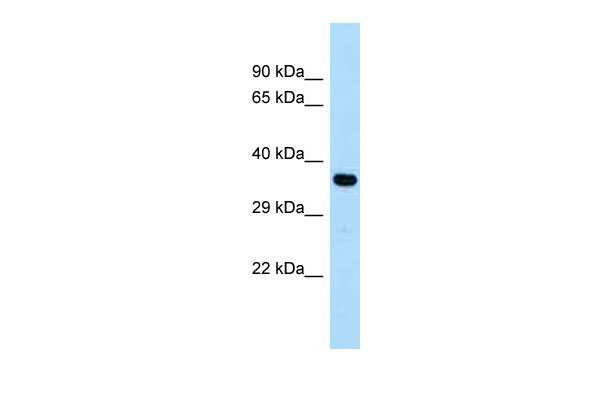CYSLTR1 antibody - C-terminal region
Rabbit Polyclonal Antibody
- SPECIFICATION
- CITATIONS
- PROTOCOLS
- BACKGROUND

Application
| WB |
|---|---|
| Primary Accession | Q9Y271 |
| Other Accession | NM_006639, NP_006630 |
| Reactivity | Human, Rabbit, Horse, Bovine, Guinea Pig, Dog |
| Predicted | Rabbit, Pig, Bovine |
| Host | Rabbit |
| Clonality | Polyclonal |
| Calculated MW | 37kDa |
| Gene ID | 10800 |
|---|---|
| Alias Symbol | CYSLT1, CYSLT1R, CYSLTR, HG55, HMTMF81, MGC46139 |
| Other Names | Cysteinyl leukotriene receptor 1, CysLTR1, Cysteinyl leukotriene D4 receptor, LTD4 receptor, G-protein coupled receptor HG55, HMTMF81, CYSLTR1, CYSLT1 |
| Format | Liquid. Purified antibody supplied in 1x PBS buffer with 0.09% (w/v) sodium azide and 2% sucrose. |
| Reconstitution & Storage | Add 50 ul of distilled water. Final anti-CYSLTR1 antibody concentration is 1 mg/ml in PBS buffer with 2% sucrose. For longer periods of storage, store at 20°C. Avoid repeat freeze-thaw cycles. |
| Precautions | CYSLTR1 antibody - C-terminal region is for research use only and not for use in diagnostic or therapeutic procedures. |
| Name | CYSLTR1 |
|---|---|
| Synonyms | CYSLT1 |
| Function | Receptor for cysteinyl leukotrienes mediating bronchoconstriction of individuals with and without asthma. Stimulation by LTD4 results in the contraction and proliferation of smooth muscle, edema, eosinophil migration and damage to the mucus layer in the lung. This response is mediated via a G-protein that activates a phosphatidylinositol-calcium second messenger system. The rank order of affinities for the leukotrienes is LTD4 >> LTE4 = LTC4 >> LTB4. |
| Cellular Location | Cell membrane; Multi-pass membrane protein. |
| Tissue Location | Widely expressed, with highest levels in spleen and peripheral blood leukocytes. Lower expression in several tissues, such as lung (mostly in smooth muscle bundles and alveolar macrophages), placenta, small intestine, pancreas, colon and heart |

Thousands of laboratories across the world have published research that depended on the performance of antibodies from Abcepta to advance their research. Check out links to articles that cite our products in major peer-reviewed journals, organized by research category.
info@abcepta.com, and receive a free "I Love Antibodies" mug.
Provided below are standard protocols that you may find useful for product applications.
References
Lynch K.R.,et al.Nature 399:789-793(1999).
Sarau H.M.,et al.Mol. Pharmacol. 56:657-663(1999).
Warren C.N.,et al.Submitted (FEB-2003) to the EMBL/GenBank/DDBJ databases.
Ota T.,et al.Nat. Genet. 36:40-45(2004).
Ross M.T.,et al.Nature 434:325-337(2005).
If you have used an Abcepta product and would like to share how it has performed, please click on the "Submit Review" button and provide the requested information. Our staff will examine and post your review and contact you if needed.
If you have any additional inquiries please email technical services at tech@abcepta.com.













 Foundational characteristics of cancer include proliferation, angiogenesis, migration, evasion of apoptosis, and cellular immortality. Find key markers for these cellular processes and antibodies to detect them.
Foundational characteristics of cancer include proliferation, angiogenesis, migration, evasion of apoptosis, and cellular immortality. Find key markers for these cellular processes and antibodies to detect them. The SUMOplot™ Analysis Program predicts and scores sumoylation sites in your protein. SUMOylation is a post-translational modification involved in various cellular processes, such as nuclear-cytosolic transport, transcriptional regulation, apoptosis, protein stability, response to stress, and progression through the cell cycle.
The SUMOplot™ Analysis Program predicts and scores sumoylation sites in your protein. SUMOylation is a post-translational modification involved in various cellular processes, such as nuclear-cytosolic transport, transcriptional regulation, apoptosis, protein stability, response to stress, and progression through the cell cycle. The Autophagy Receptor Motif Plotter predicts and scores autophagy receptor binding sites in your protein. Identifying proteins connected to this pathway is critical to understanding the role of autophagy in physiological as well as pathological processes such as development, differentiation, neurodegenerative diseases, stress, infection, and cancer.
The Autophagy Receptor Motif Plotter predicts and scores autophagy receptor binding sites in your protein. Identifying proteins connected to this pathway is critical to understanding the role of autophagy in physiological as well as pathological processes such as development, differentiation, neurodegenerative diseases, stress, infection, and cancer.


